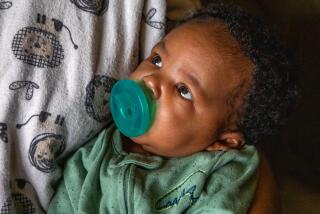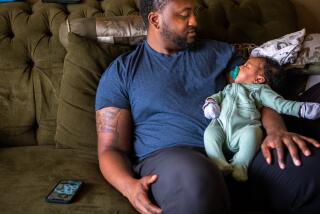Dangerous to Doze With Baby Alongside?
- Share via
When federal officials warned parents last week that they should never allow babies under the age of 2 to sleep in adult beds, mothers and fathers were left to ponder the risks of a practice that many find appealing.
The U.S. Consumer Product Safety Commission said that the practice of parents sleeping with babies posed a significant risk of accidental death from smothering or strangling. A study over an eight-year period found that 515 infants and toddlers under age 2 died as a result of sleeping in adult beds.
Rather than clarifying the issue, the warning prompted outrage and ridicule among parents, pediatricians and researchers who say that sharing a bed has many benefits for children and their parents.
“It’s one of the scientifically less substantial papers that I’ve ever seen,” said James J. McKenna, director of the University of Notre Dame’s Mother-Baby Behavioral Sleep Laboratory. The study, he said, would be “very upsetting” to parents.
The study, released last week by the American Medical Assn. and published in the group’s Archives of Pediatrics & Adolescent Medicine, warned that parents or caregivers do not recognize the dangers of adult beds and called for an alert. The study’s authors emphasized that many of the deaths were preventable.
“In many cases, the adult placing the child in the adult bed was unaware of or underestimated the danger posed by placing an infant to sleep in an adult bed,” said Suad Nakamura of the safety commission’s division of epidemiology and health sciences.
A Body of Troubling Data
Health experts have long thought that bed sharing is a risk to infants only when a parent has been using alcohol or drugs and might be less likely to realize that they’ve rolled over on the baby. But researchers found that alcohol was not a significant risk factor--with only 0.2% of the “overlying deaths” linked to alcohol use.
“There was only one incident [in the data] in which the medical examiner indicated that alcohol was involved,” Nakamura said.
Of the “structure deaths,” 42% were determined to be the result of the infant getting wedged between the mattress and a wall; 43% were due to wedging between the mattress and headboard or footboard. Eight percent were due to strangulation when the infant was entrapped at the neck between the railings of a headboard or footboard. And 7% were caused by entrapment between the mattress and an adjacent piece of furniture.
The analysis also found 79 deaths in water beds. Eight deaths occurred due to bed rails, the portable railings that can be installed on toddler or adult beds to keep occupants from falling out. Studies show an infant can become entrapped between the rail and mattress.
An infant is particularly at risk in an adult bed because its head represents 8% to 10% of its total body weight, and weak neck muscles make it difficult to move. Asphyxia can also occur if the infant’s neck is pressed against a bed frame or railing. The blood vessels in the neck are very vulnerable to compression. The authors stated that as little as 4.4 pounds of pressure can arrest blood flow in an infant’s neck.
The risk of co-sleeping is greatly reduced once a child is 2, the authors reported. Among the entrapment deaths, 69% occurred in infants younger than 6 months, and 77% of the overlying deaths were in infants 3 months or younger.
A similar analysis of children older than 2 found only 17 deaths in the same eight-year period, and eight of the deaths were among children who were severely disabled, leaving them less able to free themselves from entrapment.
The new paper is actually the second time this year that health experts have warned against bed sharing. In another analysis published in May, a researcher at the Center for Injury Research and Policy, Johns Hopkins University School of Hygiene and Public Health, examined suffocation deaths of infants under 13 months of age and found that plastic bags placed over the head by babies playing with the bags and wedging between a bed or mattress or wall were the major causes of suffocation. Those researchers also said bed sharing should be discouraged.
Advocates Insist the Practice Is Safe
But critics of both studies said the death registry data--from death certificates, coroner’s reports and newspaper stories from 1990 to 1997--is an insufficient basis for declaring bed sharing unusually unsafe.
In a letter submitted for publication to the journal Pediatrics, a copy of which was provided to The Times, three health experts complained that the suffocation data do not support the recommendation against bed sharing because the analysis did not take into account risks associated with other sleeping arrangements. For example, it did not compare the death rate for bed sharing with that of solitary crib sleeping or sleeping in playpens.
The letter’s authors, which include Dr. Maryann O’Hara of the Robert Wood Johnson Clinical Scholars Program at the University of Washington and the chief medical examiners of Washington and Maryland, also charged that it’s sometimes impossible to distinguish between suffocation and sudden infant death syndrome. For instance, one case was listed in the database only as: “baby found unresponsive, father slept in same bed; asphyxiation by overlay.”
“They absolutely do not have the database to draw those conclusions or to present such a recommendation that all babies sleep in cribs,” said the University of Notre Dame’s McKenna.
Nakamura, though, said she is confident that the deaths were all related to bed sharing.
“I counted only the incidents that stated the death was due to overlying or chest compression or that the baby was found under an adult. There was some evidence that overlying had occurred,” she said.
McKenna and other advocates of bed sharing also criticized the fact that the Archives study failed to note that co-sleeping has documented health benefits that might outweigh any risks.
For example, in a 1997 article in the journal Pediatrics, McKenna reported that infants who shared their mothers’ beds breast-fed about three times longer during the night than infants who routinely slept alone. Both bed sharing and breast-feeding may help protect against SIDS, McKenna said, because the mother’s proximity may help promote the baby’s cardiac rhythm. A study from England to be published in an upcoming issue of the British Medical Journal found that infants taken in and out of their mothers’ beds at night to breast-feed were less likely to die from SIDS than babies who slept alone, McKenna said.
“In cultures where bed sharing occurs, such as Japan, they have the lowest rates of SIDS in the world,” he says.
Warnings Could Impact Breast-Feeding
But warnings against bed sharing may erode gains that have been made in breast-feeding in the United States in recent years, McKenna said.
O’Hara, in her letter to Pediatrics, also says the recommendations are premature and might: unnecessarily limit cultural choices about infant care; subject parents to unfounded guilt or blame; obscure the need for further research; and inadvertently compromise child health.
“This is particularly important in light of evidence suggesting that co-sleeping facilitates breast-feeding, which, in turn, has significant benefits for maternal and child health,” the letter stated.
Instead of a blanket warning to stop the practice, the CPSC researchers could have solicited suggestions and pressed for more research on how to improve the safety of co-sleeping, McKenna said. Advocates of bed sharing say that safety rules should include that mattresses be firm and tight-fitting to their frames; infants should not be over-wrapped or their heads covered by blankets; babies should not be placed face-down for sleep or permitted to sleep on pillows.
Federal safety standards to prevent entrapment and strangulation in cribs are in place. They include:
* Slats should be no more than 2 3/8 inches apart, and no slats should be missing or cracked.
* The mattress should fit snugly, with less than two fingers’ width between mattress edge and crib side.
* There should be no cutouts in the headboard or footboard.
* Cribs should not be placed near draperies or blinds where a child could become entangled and strangle on cords.
The CPSC recommends children sleep in cribs until they are age 2 or reach a height of 35 inches.
A study on crib-related deaths between 1989 and 1991, using the same three databases used in the bed sharing study, showed an average of 50 accidental deaths per year in cribs. Most crib-related deaths are due to crib defects or broken parts in older cribs.






